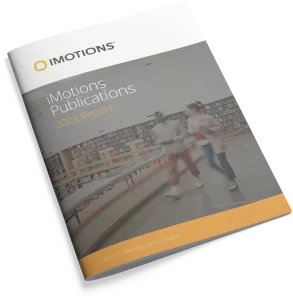We found 19 articles matching your filters.
-
A Virtual Reality Approach to Enhancing Hazard Perception in Construction Using Eye-Tracking and Deep Learning
Over 50% of onsite hazards remain unrecognised, primarily due to poor hazard perception and attention deficits. Eye-tracking can help in understanding human visual attention and cognitive response, but its application in construction has been restricted by the reliance on two-dimensional (2D) stimulus, such as pictures, which often lack realism. This study proposes a novel immersive […] -
Exploring Eye Tracking to Detect Cognitive Load in Complex Virtual Reality Training
Virtual Reality (VR) has been a beneficial training tool in fields such as advanced manufacturing. However, users may experience a high cognitive load due to various factors, such as the use of VR hardware or tasks within the VR environment. Studies have shown that eye-tracking has the potential to detect cognitive load, but in the […] -
How immersive technologies impact behavioral responses in destination marketing: the role of physiological arousal, presence, and age
Purpose This paper aims to investigate the effectiveness of immersive virtual reality (VR) media and the influence of user’s age in the context of destination marketing by exploring their impact on cognition (presence), affection (arousal), and behavioral (intention to visit and intention to recommend the destination) outcomes. Design/methodology/approach A laboratory experiment was conducted to compare […] -
The Process of Creating Interactive 360-Degree VR with Biofeedback
The paper aims to demonstrate the interconnectedness of filmmaking techniques and iterative software design methods during the creation of interactive 360-degree Virtual Reality (VR) scenarios. These scenarios, which were designed to treat social anxiety disorder (SAD), comprised of six distinct simulations. To track patients’ biodata, biosensors were integrated with the developed scenarios. In the paper, […] -
Development of an Immersive Virtual Reality Prototype to explore the social mechanisms of the last planner system
A successful iA successful implementation of the Last Planner® System (LPS) requires not only education on its principles, but also managing social mechanisms it brings up to reach outstanding outcomes. Simulation games have been widely applied to teach LPS principles, but they do not seem to appropriately capture the social mechanisms due to lack of […] -
Visual Attention to Biophilic Elements in Virtual Classroom Design: A VR Eye-Tracking Study
Recently, interest in indoor nature-based solutions through biophilic design interventions has grown across various spatial contexts. This study examines the influence of biophilic elements in virtual classroom design on university students’ visual attention, utilizing eye-tracking integrated with VR technology. This study focuses on how eye-tracking can provide insights into attention processes in relation to biophilic […] -
Towards a typology of virtual tourists: Efficacy of visual patterns and attentional cues
Virtual tourism is rapidly emerging in prominence in contemporary tourism research. Previous studies tend to consider the virtual tourism population as a homogeneous entity, resulting in unintended consequences. Despite the ocular-centric nature within virtual environments, existing eye tracking studies have rarely classified virtual tourists into benefit-based segments, discounting the critical role of pre-existing visual patterns and associated […] -
Developing 360-degree stimuli for virtual tourism research: a five-step mixed measures procedure
Virtual reality has emerged as a powerful tool for the design of immersive tourism experiences. Prior studies have primarily relied on externally produced 360-degree stimuli, with the potential to undermine causal inference among concepts and increase risk of flattening real-world responses. Consequently, building on design principles embedded in human–computer interaction, this paper draws on an […] -
UX assessment strategy to identify potential stressful conditions for workers
The European Commission defined the new concept of Industry 5.0 meaning a more human-centric, resilient, and sustainable approach for the design of industrial systems and operations. A deep understanding of the work environment and organization is important to start analysing the working conditions and the resulting User eXperience (UX) of the operators. Also, the knowledge […] -
Investigating the impact of greenery elements in office environments on cognitive performance, visual attention and distraction: An eye-tracking pilot-study in virtual realityUnveiling impact dynamics: Discriminatory brand advertisements, stress response, and the call for ethical marketing practices
The human-nature connection is one of the main aspects determining supportive and comfortable office environments. In this context, the application of eye-tracking-equipped Virtual Reality (VR) devices to support an evaluation on the effect of greenery elements indoors on individuals’ efficiency and engagement is limited. A new approach to investigate visual attention, distraction, cognitive load and […] -
A Comparative Study of Real and Virtual Environment via Psychological and Physiological Responses
Currently, immersive virtual environments (IVE) are widely used in fields such as architecture and environmental psychology. These simulated environments allow for a detailed evaluation of how different designs impact users’ perception and interaction with the built environment, under controlled conditions and without incurring high costs. The validity of these IVEs is related to their capacity […] -
Visual Analysis and Recognition of Virtual Reality Resolution Based on Pupil Response and Galvanic Skin Response
The ability to efficiently assess the resolution of VR videos is critical for the implementation and advertising of VR products. Pupil responses and Galvanic Skin Response (GSR) are direct and objective mirrors of the emotional activity of humans. They are unaffected by subjective will and has excellent real-time performance, which can be used for VR […] -
Examining the Impact of Stress and Fear of COVID-19 on Transit Travel
The COVID-19 pandemic altered daily life by forcing governments to issue measures for the prevention of the spread of the disease such as stay-at-home orders, requiring face coverings, and maintaining physical distancing, among others. This caused a significant disruption in every aspect of people’s lives. This disruption was prominent in the transportation sector where travel […] -
Examination of gaze behaviour in social anxiety disorder using a virtual reality eye-tracking paradigm: protocol for a case–control study
Social anxiety disorder (SAD) has an early onset, a high lifetime prevalence, and may be a risk factor for developing other mental disorders. Gaze behaviour is considered an aberrant feature of SAD. Eye-tracking, a novel technology device, enables recording eye movements in real time, making it a direct and objective measure of gaze behaviour. Virtual […] -
Experimental Setup and Protocol for Creating an EEG-signal Database for Emotion Analysis Using Virtual Reality Scenarios
Automatic emotion recognition systems aim to identify human emotions from physiological signals, voice, facial expression or even physical activity. Among these types of signals, the usefulness of signals from electroencephalography (EEG) should be highlighted. However, there are few publicly accessible EEG databases in which the induction of emotions is performed through virtual reality (VR) scenarios. […] -
Cognitive behavioral therapy with adaptive virtual reality exposure vs. cognitive behavioral therapy with in vivo exposure in the treatment of social anxiety disorder
Social anxiety disorder (SAD) has a high prevalence and an early onset with recovery taking decades to occur. Current evidence supports the efficacy of cognitive behavioral therapy (CBT) with virtual reality (VR) exposure. However, the evidence is based on a sparse number of studies with predominantly small sample sizes. There is a need for more […] -
Work-in-progress-Gamifying the process of Learning Sign Language in VR
This study recognizes the need for providing a tool to facilitate learning British Sign Language (BSL). Virtual reality coupled with gamification holds exciting prospects to accommodate this need. This paper presents a work-in-progress study that focuses on evaluating the impact of combining scaffolded instruction with gamification to design a 3D interactive game to support learning […] -
Cognitive and emotional engagement while learning with VR: The perspective of multimodal methodology
This study uses a multimodal data analysis approach to provide a more continuous and objective insight into how students’ engagement unfolds and impacts learning achievements. In this study, 61 nursing students’ learning processes with a virtual reality (VR)-based simulation were captured by psycho-physiological data streams of facial expression, eye-tracking, and electrodermal activity (EDA) sensors, as well […] -
Situation Awareness Assessment for Ship Navigation Tasks in Virtual Reality Simulation System
This paper discusses whether the ergonomic assessment of the man-machine interface of the ship console in virtual reality simulation system can achieve the effect similar to that in physical simulation system. The similarity of the two systems was verified by assessing the situation awareness level of the subjects. 9 subjects were recruited to participate in […]
Research Report 2024
In-depth look at the scientific landscape as powered by iMotions software, showcasing groundbreaking research and the impact of our tools in various scientific and industrial fields.

iMotions Science Resources
Looking for white papers, validation reports or research show casing iMotions Multimodal capabilities?
Share Your Research

850+ universities worldwide with an iMotions human behavior lab
73 of the top 100 highest ranked universities
710+ published research papers using iMotions
iMotions is used for some of the most interesting human behavior research studies carried out by top researchers around the world. Contact us to have your publication featured here.
The authors of these publications have used iMotions as a software tool within their research.
“Software should be cited on the same basis as any other research product such as a paper or a book; that is, authors should cite the appropriate set of software products just as they cite the appropriate set of papers” (Katz et al., 2020).
We therefore encourage you to cite the use of iMotions where appropriate.
How to cite iMotions
APA
iMotions (10), iMotions A/S, Copenhagen, Denmark, (2024).
Note: adjust the version and year where relevant.
Publications
Read publications made possible with iMotions
Blog
Get inspired and learn more from our expert content writers
Newsletter
A monthly close up of latest product and research news


